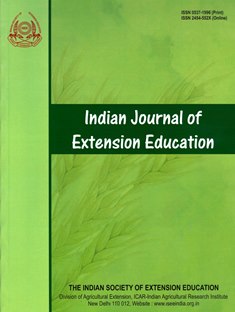Cropping Scenario in Water User Associations (WUAs) Managed Groundwater Irrigation System’s Command Area in West Bengal
DOI:
https://doi.org/10.48165/IJEE.2023.59104Keywords:
Irrigation, Groundwater, Farmers, Participatory irrigation managementAbstract
The groundwater irrigation, catering to more than 60 per cent of total irrigation in India, has significantly contributed to food grains production. Participatory irrigation management programme has been implemented transferring irrigation management to WUAs. Present study was undertaken during 2019 to explore cropping scenario in groundwater irrigation command under jurisdiction of WUAs in Burdwan district of West Bengal covering a random sample of 120 farmers. It is revealed that paddy was the major crop in both kharif and summer season. During rabi season, potato was grown in larger areas followed by mustard. While all 120 farmers had grown paddy as single crop in kharif season, 100 and 82 farmers have cultivated potato and mustard in rabi season and 75 farmers have grown boro rice during summer season. Cultivated land utilization index value was more than 50 per cent. Crop diversity index (CDI) value of 36 per cent showed lack of crop diversification in groundwater irrigation command areas that warrants need of bringing more areas under different crops. Multiple cropping index of 176 per cent showed a higher cropping intensity in groundwater irrigation command. Thus, Extension advisory services need to promote crop diversification in groundwater irrigation command areas through proper crop planning and capacity building of WUAs.
Downloads
References
Central Ground Water Board (2014). Dynamics Groundwater Resources of India. Central Ground Water Board, Ministry of Water Resources, River Development & Ganga Rejuvenation, Government of India: New Delhi.
Gany, A. H. A., Sharma, P., & Singh, S. (2019). Global review of institutional reforms in the irrigation sector for sustainable agricultural water management, including water users associations. Irrigation and Drainage, 68, 84–97.
Gautam, A., Singh, V., & Aulakh, G. S. (2021). Performance of paddy cultivation under different methods in south-eastern part of Punjab, India. Indian Journal of Extension Education, 57(4), 131-134.
Ghosh, S., & Kumar, A. (2012). How participatory irrigation management reform influences agriculture performance. Current Science, 103(4), 359-360.
Ghosh, S., Brahmanand, P. S., Mandal, K. G., Nanda, P., & Patil, D. U. (2016). How participatory is participatory irrigation management? Indian Journal of Extension Education, 52(3&4), 1-6.
Ghosh, S., Gorain, S., & Mondal, B. (2017). Spatio-temporal variations and links between irrigation and agricultural development in an eastern Indian state. Irrigation and Drainage, 66, 784-796.
Ghosh, S., Kolady, D. E., Das, U., Gorain, S., Srivastava, S. K., & Mondal, B. (2019). Spatio-temporal variations in effects of participatory irrigation management (PIM) reform in India: a panel data analysis. Agricultural Water Management, 222, 48- 61.
Ghosh, S., Srivastava, S. K., Nayak, A. K., Panda, D. K., Nanda, P., & Kumar, A. (2014). Why impacts of irrigation on agrarian dynamism and livelihood are contrasting: evidence from eastern Indian states. Irrigation and Drainage, 63, 573-583.
Kaur, M., & Sharma, K. (2022). Rice productivity and water use efficiency under different irrigation management system in north western India. Indian Journal of Extension Education, 58(2), 65-68.
Madramootoo, C. A., & Fyles, H. (2010). Irrigation in the context of today’s global food crisis. Irrigation and Drainage, 59, 40-52. Mishra, A., Ghosh, S., Nanda, P., & Kumar, A. (2011). Assessing the impact of rehabilitation and irrigation management transfer in minor irrigation project in Odisha, India: A case study. Irrigation and Drainage, 60, 42-56.
Mukherjee, S., Roy, A., & Ghosh, S. (2022). Performance of groundwater irrigation system as perceived by farmers in West Bengal. Indian Journal of Extension Education, 58(3), 157-162.
Pharande, S. S. (2015). Minor Irrigation Projects & Agricultural Development in Maharashtra. Implication of water scarcity on agriculture and employment CKT College, New Panvel.
Restrepo, C. G. (2004). Effect of participatory irrigation management on agricultural yields and system performance. International Network on Participatory Irrigation Management Institute, Mexico.
Srivastava, S. K., Ghosh, S., Kumar, A., & Brahmanand, P. S. (2014). Unraveling the spatio-temporal pattern of irrigation development and its impact on Indian agriculture. Irrigation and Drainage, 63, 1–11.
Srivastavaa, S. K., Kumar, R., & Singha, R. P. (2009). Extent of groundwater extraction and irrigation efficiency on farms under different water-market regimes in central Uttar Pradesh. Agricultural Economics Research Review, 22, 87-97.
Downloads
Published
Issue
Section
License

This work is licensed under a Creative Commons Attribution-NonCommercial-NoDerivatives 4.0 International License.

